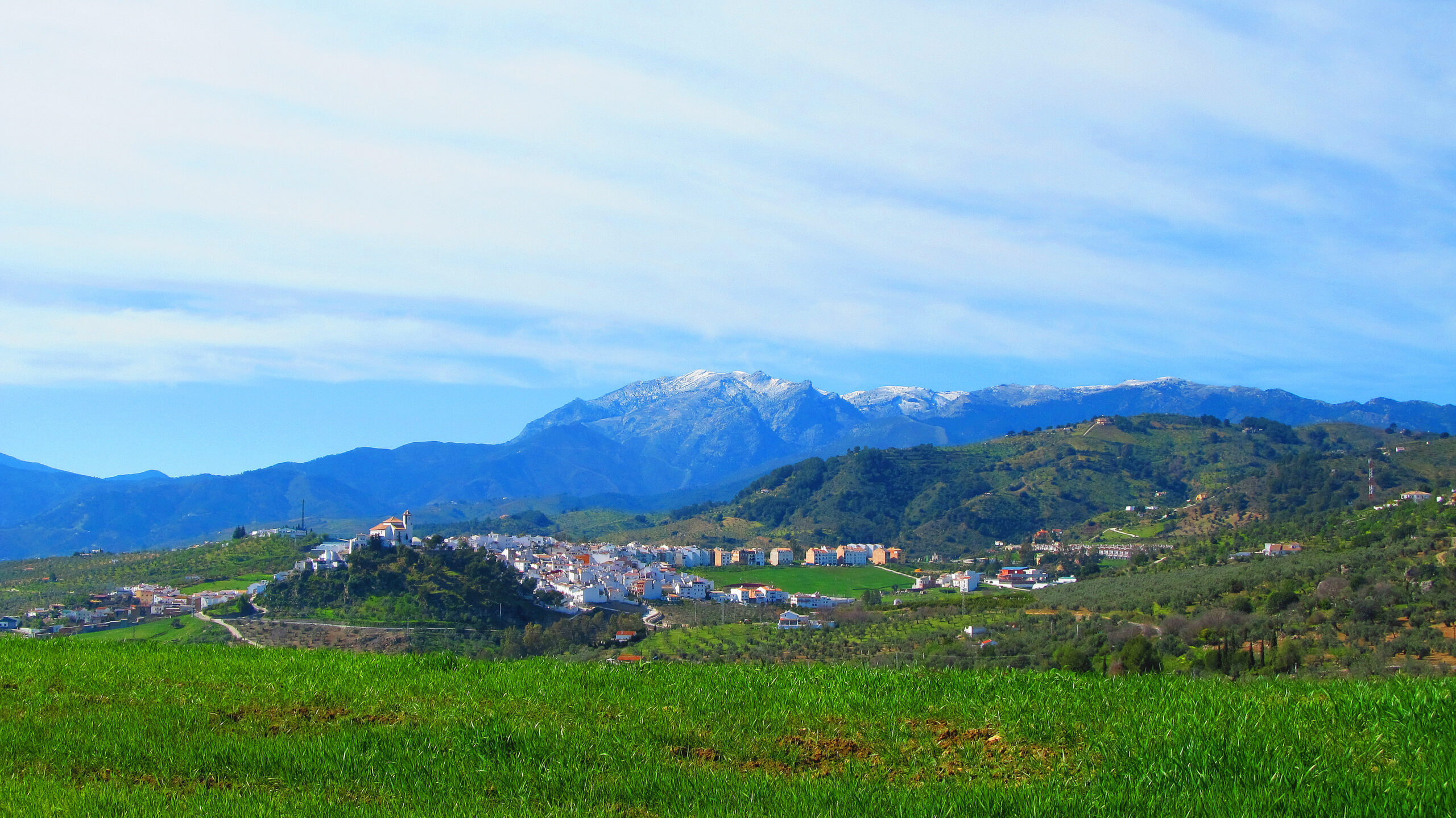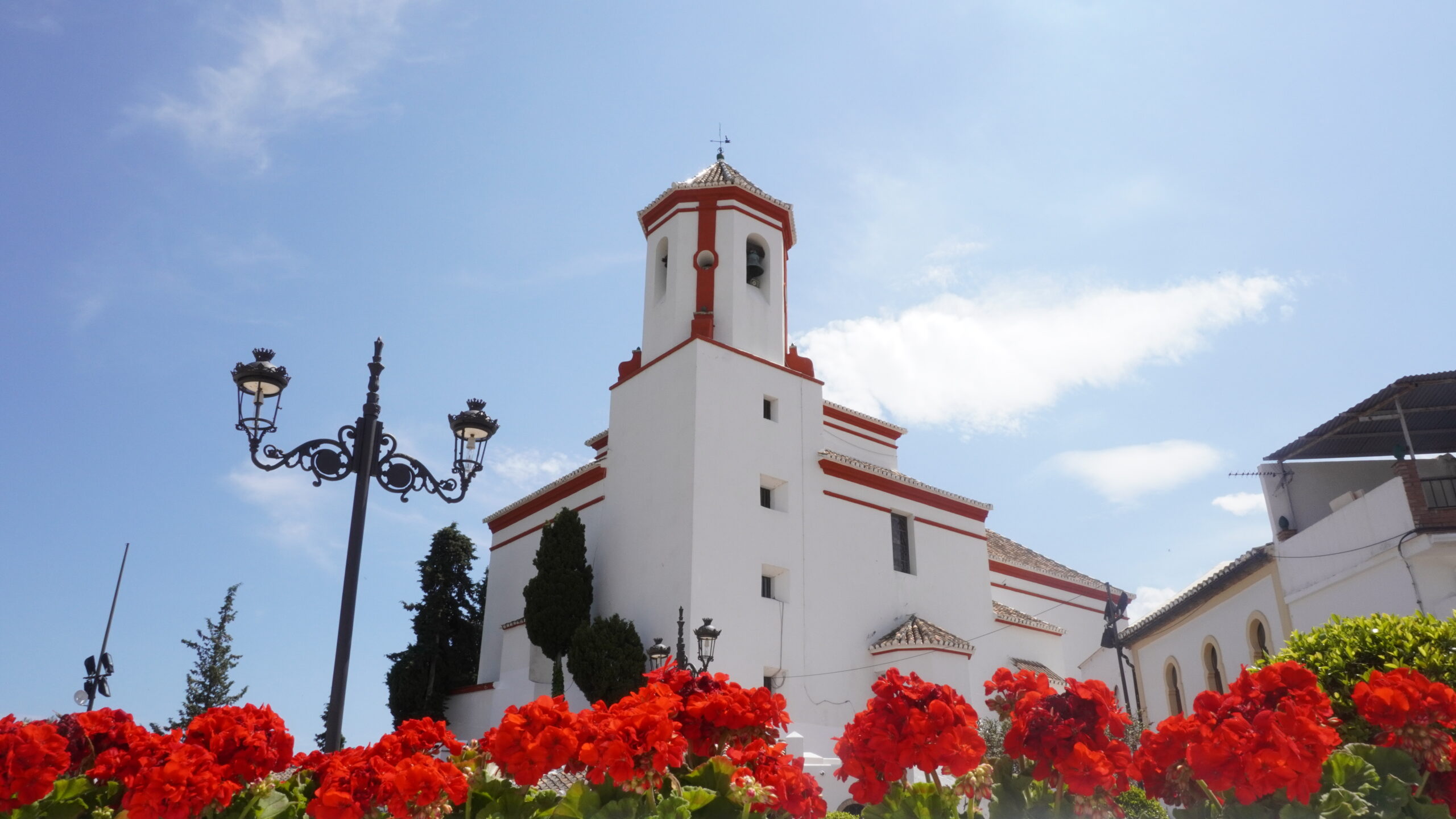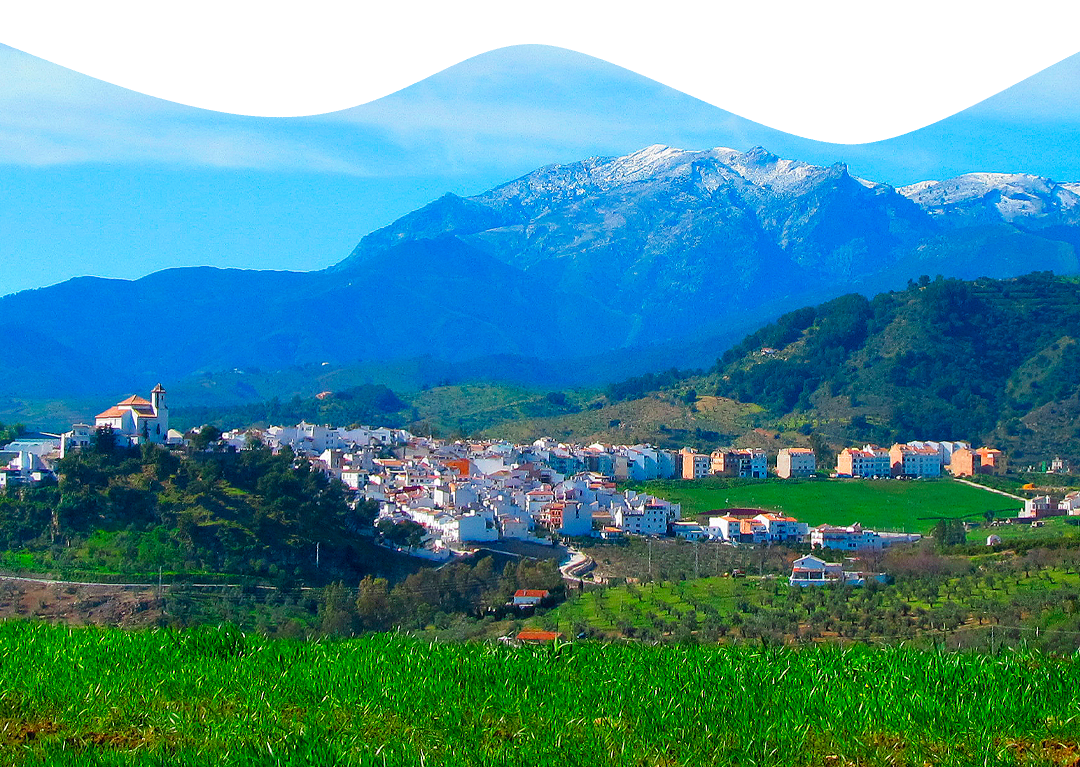CONOCE ALOZAINA
El pueblo de Alozaina ocupa una posición ligeramente elevada en el borde occidental de la Comarca del Valle del Guadalhorce. Sus tierras se extienden desde el Valle de Río Grande (afluente del Guadalhorce), al sur, hasta la cima de Sierra Prieta, al norte, poniendo en contacto, de este modo, las tierras del Valle con las montañas orientales de la Serranía de Ronda. Esto permite a Alozaina disfrutar de un paisaje natural variado, que encuentra en las laderas de Sierra Prieta sus más bellos parajes, especialmente el de la Ventanilla.
Alozaina, que significa pequeña fortaleza, lugar bueno y sano, de Alozaina, vista general silueta altiva y bella, marca el tránsito entre la Hoya de Málaga y la Sierra. Sus tierras, ricas en restos arqueológicos, combinan armoniosamente importantes cultivos de olivos, frutales y cereales que sustentan la economía local con la majestuosidad de Sierra Prieta, cuya cima alcanza los 1.525 metros de altitud.
Pascual Madoz nos mencionaba de la siguiente forma en el Diccionario de España y sus posesiones de Ultramar:
“…la sierra llamada Prieta, ofrece desde su cumbre el punto de vista más agradable, por los deliciosos sitios que mira a sus pies, y a una dilatada extensión; pues desde ella se descubre el Mediterráneo, gran porción de la costa de África, parte de la ciudad de Málaga, su castillo de Gibralfaro y toda su Hoya, la salina de Fuente Piedra y parte del Reino de Sevilla.”
Su escudo representa la acción de María Sagredo, heroína de la Villa, que la defendió arrojando colmenas de abejas a los moriscos, al mando de Zebali que intentaban tomarla, aprovechando un momento en que solo estaba ocupada por mujeres, niños y ancianos, durante la rebelión de 1570.
No cabe duda que una visita a Alozaina requiere de tiempo suficiente para pasear por sus calles y rincones, con la típica arquitectura de estos pueblos serranos que forman nuestra comarca. Los vecinos, llamados pecheros, lo saben, y la historia, que denominó a este pueblo como “un lugar bueno y sano”, convirtió a Alozaina en un rincón especial para disfrutar del descanso amigable y acogedor de la tierra que mira al valle.
Premios al municipio
En 1977 se le otorgo a Alozaina 1º Premio Nacional de Embellecimiento de los pueblos de España. Alozaina y su pedanía, el Valle de Jorox, enclave natural con una variedad paisajística inolvidable, ha cultivado desde tiempos ancestrales espléndidas labores artesanas que perduran en este municipio antiguos oficios, como la fragua.
Alozaina ofrece de todo un poco: parque nacional, vistas de ensueño, rica gastronomía, alojamientos de calidad, artesanía viva, una casa reposo para amantes de la vida espiritual, un ciclo festivo que se caracteriza por ser uno de los más ricos de la comarca, original es el Carnaval de la Harina; los pecheros se enharinan en medio de un gran jolgorio y ambiente festivo.


Localización exacta
Perteneciente a la Comarca de Sierra de las Nieves, Alozaina se encuentra a una altura de 386 m de altura sobre el nivel del mar, teniendo una extensión de 34 Km² y una latitud 36° 43′ y longitud -4º 51′, situada a 50 km al NO. de la Capital de la Provincia, MÁLAGA, la temperatura media anual es de 17 °C y cuenta con 2300 habitantes.
Alozaina limita al Norte y al NO con el municipio de Casarabonela, al Oeste se encuentra el municipio de Coín, limitando con el municipio de Guaro al Sur, al SE con el municipio de Tolóx y al Este con el Municipio de Yunquera.
Gentilicio
El gentilicio es Pecheros y Pecheras: hacia alusiónal ser cumplidores en los pagos, obligado a pagar o contribuir con pecho, es decir, con impuestos. No todos debían hacer estas clases de pagos, solo aquellos que pertenecían al estamento más bajo de la sociedad, de ahí que se llamara pecheros a las personas en esta situación.
Un poco de Historia
DESDE EL PALEOLÍTICO
Es interesante empezar citando la existencia de numerosos restos fósiles: nummulites, trilobites… en lo que fue el lago o mar de los Gavilanes, restos de aquel mar de Tetis de la era Secundaria y en torno al cual se asentaron los primeros pobladores de la zona.
Los primeros restos de hábitat se encontraron en el partido de Joróx, en la “Cueva del Algarrobo o de las vacas”, donde se encontraron útiles de caza del período Solutrense del Paleolítico Superior y en la “Cueva de la Mesa” se descubrió un enterramiento y dos trompetillas de oro de la Edad del Bronce, que se encuentran en el Museo Arqueológico de Málaga.
ÍBEROS
De la época de los Íberos o tal vez fenicio, se han encontrado tumbas con vasijas decoradas y otros objetos.
ROMANOS
Los romanos también nos dejaron su huella en el partido del Monte (zona de Albar): una columna y una especie de ara y también se encontraron restos romanos en el partido de Ardite.
Aún está por saberse cómo surgió el poblado de ALBAR, que estaría situado en el camino de Casarabonela a Alozaina y de él solo sabemos su nombre.
ÉPOCA MUSULMANA
Con la llegada de los musulmanes se construyen las atalayas de Ardite y de ALOZAINA, que se convertiría en una pequeña fortaleza, origen de la actual villa de Alozaina.
Los cristianos mozárabes dejaron testimonio de un poblamiento, quizás continuación de Albar, en el actual partido de los HOYOS DE LOS PEÑONES: una “Ermita Mozárabe” y una “Necrópolis” del s. XI.
De los siglos IX y X existen noticias documentales de ALHOSAYNA y de JORIN o JOROL.
La etimología de la palabra “Alozaina” es diversa: unos le dan el significado de Lugar sano y templado, otros de Pequeña Fortaleza, y otros como derivado de un nombre de mujer, femenino de Husein el bueno, por lo que significaría la Buena.
Los musulmanes, además del castillo y de la forma urbanística del casco viejo, nos dejaron un acueducto procedente de la zona de Albar por el camino viejo de Casarabonela, con acequia de arcilla y teja.
Durante la dominación árabe, el núcleo urbano fue evolucionando, construyéndose nuevas casas alrededor de las murallas de la fortaleza.
Su economía se basaba en la agricultura: pasas, ceretes de higos, almazara, almendras y sobre todo agrios, especialmente en Joróx, donde nos ha quedado el actual regadío, e incluso una de sus acequias se denomina Acequia del Moro.
Toda esta felicidad se vería truncada por la Reconquista de los Reyes Católicos. El 20 de junio de 1484, rendida Álora, el Marqués de Cádiz envía a su hermano Diego y al alcaide de Arcos a posesionarse de la villa de Alozaina, capitulando el día 21 los alfaquíes de la villa, ordenándoseles conservar sus bienes y haciendas.
A la vuelta de esta embajada y con el fin de unirse a las tropas del Marqués de Cádiz, que ponían sitio a Casarabonela, tiene lugar una escaramuza en la que muere el “conde lozano don Gutiérrez de Soto Mayor”, conde de Belalcázar, joven querido de los reyes y casado con una prima del monarca.
LOS CRISTIANOS
Sospechándose la participación de algunos moros de Alozaina, se quemaron y talaron, como castigo, gran parte de sus tierras, lo que provocó un despoblamiento de la villa, que fue repoblándose con cristianos viejos entre 1485 y 1490 a través de Carta Real.
En 1498 se funda la parroquia de Alozaina, dependiente de la de Casarabonela hasta el siglo XVI, con el nombre de Santa María.
La torre de Alozaina y gran parte de sus tierras son concedidas a Garci Fernández Manrique, de la que disfrutarían sus descendientes, los Condes de Frigiliana y los duques de Montellano.
Es en estas fechas cuando se acuña el apelativo gentilicio de “PECHEROS”, con el que se denomina a los habitantes de Alozaina. El vocablo “Pechero” viene del tributo “pecho”, los primeros en pagar los impuestos.


12 DE OCTUBRE DE 1492
La villa de Alozaina es declarada municipio en Sevilla.
En 1494 se crea el Mayorazgo de don Enrique de Lara, que junto con las tierras de los alcaides de Yunquera y Tolóx ocupaban el 85 % de su jurisdicción, no teniendo apenas sus habitantes para comer, lo que motivo que fuera repoblado por segunda vez.
Sabemos de la mala situación de sus vecinos por la carta que los RRCC mandan a Málaga, ordenando que los vecinos guardasen su condición como tales y que no se fueran (1502).
8 DE JULIO DE 1568: EL VALOR DE MARÍA SAGREDO
600 moriscos sublevados, al mando de Lorenzo Alfaquí y el Jubeli atacaron la villa de Alozaina, cuando la mayoría de sus habitantes estaban en el campo segando los panes. No había en el lugar más de siete hombres, mujeres y niños, cuando la población era de unos trescientos habitantes.
Ante el ataque de los moriscos se refugiaron en el castillo, y las mujeres, animadas por los hombres, hacían el oficio de esforzados varones, acudiendo a la defensa de los muros con sombreros y monteras en la cabeza y vestidas con sus capotillos, para que el enemigo creyera que eran los hombres los que defendían la fortaleza.
Destacó el valor de una doncella llamada María Sagredo, quien viendo caído a MARTIN DOMÍNGUEZ, su padre, de un escopetazo que le había dado un moro, llegó a él, se puso su capotillo y una celada en la cabeza y con la ballesta en una mano y la aljaba en la otra, subió al muro, defendió el portillo, mató a un moro e hirió a otros muchos de saeta y lanzó contra ellos unas colmenas que los hicieron huir mientras exclamaban los unos y los otros “María, que pican las moscas de tu tierra”.
Esta hazaña mereció que por parte del Rey Felipe II se la nombrara Alférez de los Tercios españoles y le diera unas haciendas de moriscos en Tolóx para su casamiento.
Este hecho está recogido en el Escudo Heráldico de Alozaina.
Surgen en este siglo XVI las actuales Cofradías y Hermandades religiosas del Santísimo Sacramento, de la Santa Vera Cruz y de Nuestro Padre Jesús Nazareno, que durante estos cuatro siglos han tenido singular importancia en la vida del pueblo.
SIGLO XIX
Durante el siglo XIX, de las 2.400 fanegas de tierra del término municipal, más de la mitad pertenecían a la Duquesa de Montellano y de las restantes pertenecientes a los vecinos, parte de ellas tenían censos a favor de la Duquesa.
En 1864 se funda la actual Banda de Música por un maestro llamado Francisco Sánchez y a finales del siglo XIX se creó un periódico “El Reformista Administrativo”, cuyo director fue F. Martín de la Cruz.
En 1998 y concretamente el día 15 de febrero, se realiza en Alozaina el primer referéndum español sobre la reducción de la jornada laboral a 35 horas semanales, siendo ampliamente respaldado por los vecinos de la villa.


